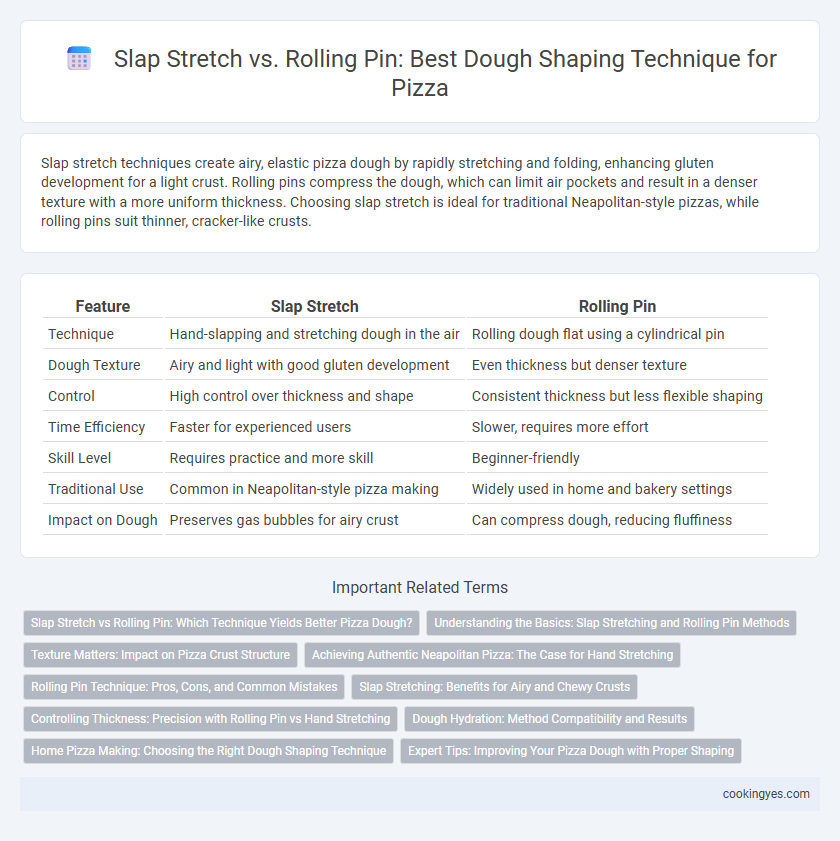Slap stretch techniques create airy, elastic pizza dough by rapidly stretching and folding, enhancing gluten development for a light crust. Rolling pins compress the dough, which can limit air pockets and result in a denser texture with a more uniform thickness. Choosing slap stretch is ideal for traditional Neapolitan-style pizzas, while rolling pins suit thinner, cracker-like crusts.
Table of Comparison
| Feature | Slap Stretch | Rolling Pin |
|---|---|---|
| Technique | Hand-slapping and stretching dough in the air | Rolling dough flat using a cylindrical pin |
| Dough Texture | Airy and light with good gluten development | Even thickness but denser texture |
| Control | High control over thickness and shape | Consistent thickness but less flexible shaping |
| Time Efficiency | Faster for experienced users | Slower, requires more effort |
| Skill Level | Requires practice and more skill | Beginner-friendly |
| Traditional Use | Common in Neapolitan-style pizza making | Widely used in home and bakery settings |
| Impact on Dough | Preserves gas bubbles for airy crust | Can compress dough, reducing fluffiness |
Slap Stretch vs Rolling Pin: Which Technique Yields Better Pizza Dough?
Slap stretch enhances gluten development by promoting air retention, resulting in a lighter, chewier pizza dough compared to the rolling pin method, which compresses the dough and can create a denser crust. Professional pizzaiolos often prefer slap stretching for its ability to preserve the dough's natural texture and maintain optimal thickness without overworking the gluten. While rolling pins provide uniform thickness and ease for novices, slap stretching yields superior dough elasticity and a more traditional Neapolitan-style pizza crust.
Understanding the Basics: Slap Stretching and Rolling Pin Methods
Slap stretching involves quickly tossing and stretching the dough by hand to create an airy, uneven crust texture ideal for Neapolitan-style pizza, while the rolling pin method flattens the dough uniformly, producing a denser, consistent base suited for thicker crusts. Slap stretching preserves the dough's natural gas bubbles, enhancing flavor and chewiness, whereas rolling pins compress the dough, reducing air pockets and resulting in a firmer bite. Understanding these fundamental techniques helps pizza makers choose the optimal method based on desired crust texture and style.
Texture Matters: Impact on Pizza Crust Structure
Slap stretch dough technique creates an airy, open crumb by developing gluten strands with light, forceful handling, resulting in a chewier, more textured pizza crust. Rolling pins compress the dough uniformly, often producing a denser structure with less pronounced air pockets, leading to a thinner, crispier crust. Understanding the impact of these stretching methods enhances control over the final pizza texture, crucial for achieving desired crust characteristics.
Achieving Authentic Neapolitan Pizza: The Case for Hand Stretching
Hand stretching dough, also known as slap stretching, preserves the delicate gluten structure essential for an authentic Neapolitan pizza crust, creating a tender yet chewy texture unattainable with a rolling pin. This technique allows for a thin center and puffed, blistered cornicione, hallmark traits of traditional Neapolitan pies cooked at high temperatures in wood-fired ovens. Using a rolling pin can compress the dough, resulting in a denser, less airy base that compromises the signature lightness and texture prized in Neapolitan pizza.
Rolling Pin Technique: Pros, Cons, and Common Mistakes
Using a rolling pin for pizza dough shaping ensures consistent thickness and a smooth surface, ideal for thin-crust pizzas. However, overuse can compress the dough excessively, resulting in a denser, less airy crust. Common mistakes include applying uneven pressure and rolling too quickly, which can cause tearing or uneven thickness.
Slap Stretching: Benefits for Airy and Chewy Crusts
Slap stretching dough enhances gluten development, resulting in an airy and chewy crust that is difficult to achieve with a rolling pin. This technique introduces more oxygen into the dough, promoting fermentation and creating a light texture with crisp edges. Pizza artisans favor slap stretching for its ability to preserve dough structure, leading to a superior crust quality ideal for Neapolitan and artisan-style pizzas.
Controlling Thickness: Precision with Rolling Pin vs Hand Stretching
Using a rolling pin for dough shaping offers precise control over thickness, allowing even flattening to a consistent measurement, which is ideal for uniform crusts. In contrast, hand stretching or slap stretching provides a more tactile approach, enabling gradual thinning and better retention of air bubbles for a light, airy texture. While rolling pins risk overworking the dough and losing elasticity, hand stretching preserves dough structure, enhancing crust softness and chewiness.
Dough Hydration: Method Compatibility and Results
Slap stretch technique excels in handling high-hydration pizza doughs by gently stretching without deflating the air bubbles, preserving the dough's light and airy texture. Rolling pins are better suited for lower hydration doughs, as they compress the dough and can reduce its volume, resulting in a denser crust. Optimal dough hydration levels paired with the correct shaping method significantly impact the final pizza's texture and rise during baking.
Home Pizza Making: Choosing the Right Dough Shaping Technique
Slap stretch enhances gluten development by aerating the dough, creating a light and airy crust ideal for Neapolitan-style pizzas, while rolling pins tend to compress the dough, resulting in a denser texture more suitable for thin-crust varieties. Home pizza makers benefit from slap stretching as it preserves dough elasticity and maintains gas bubbles, leading to better rise and chewiness. Rolling pins offer a quicker, more uniform thickness but sacrifice some dough structure, making the choice dependent on desired crust characteristics and personal skill level.
Expert Tips: Improving Your Pizza Dough with Proper Shaping
Using a slap stretch technique enhances gluten development in pizza dough, creating an airy, chewy crust with better oven spring. Rolling pins tend to compress the dough, reducing air pockets and resulting in a denser texture. Experts recommend mastering slap stretching for optimal dough elasticity and superior crust texture in Neapolitan and artisan-style pizzas.
Slap Stretch vs Rolling Pin for dough shaping Infographic

 cookingyes.com
cookingyes.com